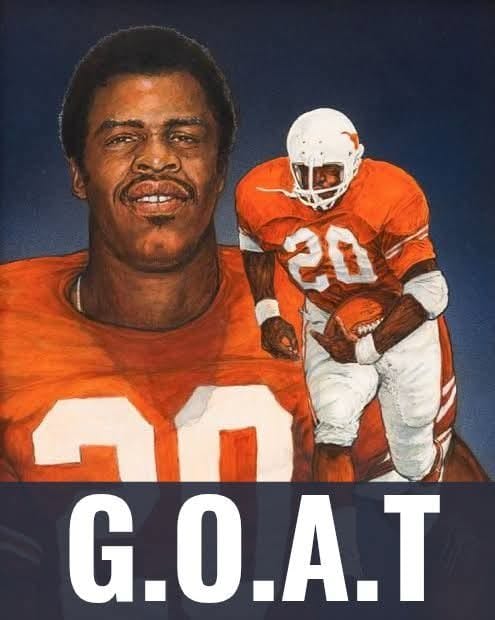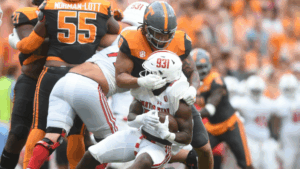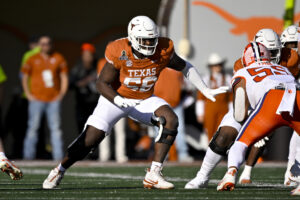
Texas Longhorns’ Legend Earl Campbell has been named as the The Greatest of All Time in College Football, beating Herschel Walker of Georgia, Tim Tebow of Florida Gators and Archie Griffin of OHIO
In the ever-evolving world of college football, certain players transcend the sport’s boundaries, leaving an indelible mark on its history. Earl Campbell, the legendary running back from the University of Texas, has been named the greatest college football player of all time, surpassing a list of elite contenders like Herschel Walker (Georgia), Tim Tebow (Florida Gators), and Archie Griffin (Ohio State). Campbell’s journey to this prestigious title is not merely one of athleticism but also one of passion, resilience, and an unparalleled level of dominance in the game. Let’s explore why Earl Campbell deserves this recognition and how his legacy as the GOAT (Greatest of All Time) in college football has been solidified.
Before we dive into Campbell’s monumental college career, it is essential to understand the foundation that led him to greatness. Earl Christian Campbell was born on March 29, 1955, in Tyler, Texas, where his family’s modest background instilled in him values of hard work and perseverance. Growing up in a town known for its love of football, Campbell began playing the sport at a young age. His incredible physical attributes, such as his 6-foot-1, 230-pound frame, were evident even in his youth. Yet it was his mental toughness and determination that would set him apart from other players in the future.
Campbell attended John Tyler High School in Tyler, Texas, where his athletic talents began to shine brightly. He was not only a star on the football field, but he also excelled in track and field, demonstrating the type of explosiveness and agility that would later make him a force to be reckoned with in college football. By the time Campbell graduated, it was clear he had the potential to make waves at the collegiate level.
Earl Campbell enrolled at the University of Texas in 1974, where he would go on to become one of the most iconic players in college football history. His arrival at Texas was a game-changer for the Longhorns program, but it wasn’t immediate stardom. Initially, Campbell had to bide his time behind other running backs before earning his place as the starting tailback. However, once he got his chance, the football world would never be the same.
Campbell’s first season as a starter in 1974 was a precursor to what would become a legacy of dominance. He rushed for over 900 yards in his sophomore year and began to showcase his powerful running style, characterized by a combination of speed, agility, and a willingness to run through defenders. The following season, in 1975, Campbell’s breakthrough year, he rushed for 1,400 yards and 19 touchdowns, leading the Longhorns to an 11-1 record and a berth in the Cotton Bowl. His performance that year not only cemented his place as one of college football’s rising stars but also set the stage for his senior year, which would become a historic campaign.
In 1977, Campbell’s senior year, he delivered a season that would solidify his legacy as one of the greatest to ever play the game. He rushed for a staggering 1,744 yards and 19 touchdowns, leading the nation in rushing yards and earning the prestigious Heisman Trophy. His dominance was so profound that defenders simply had no answers for his style of play. Campbell’s unique blend of power, speed, and determination made him virtually unstoppable on the field.
What made Earl Campbell such a compelling player was his combination of traits that defied conventional expectations. At 230 pounds, he was built like a bruising fullback, yet he possessed the speed and agility of a smaller running back. His running style was best described as a relentless force—Campbell could bulldoze through defenders with his sheer physicality, but he was also more than capable of outrunning them in open space. Many players were fast, many were strong, but Campbell possessed both in spades.
In addition to his physical prowess, Campbell’s ability to make defenders miss was another hallmark of his game. He employed a unique stiff-arm technique that allowed him to shed would-be tacklers with ease. Opposing teams knew that stopping Campbell was an almost impossible task, as he had the rare ability to take over a game at any moment.
Moreover, Campbell was a player who elevated his team. Texas was ranked No. 1 in the nation for several weeks during his senior season, and he was often the focal point of the Longhorns’ offense. The fear and respect Campbell commanded from opposing defenses are what made him such an essential player. His ability to control the game not just with his physicality but with his mental toughness made him an irreplaceable asset for Texas.
Campbell’s individual achievements during his college career are numerous, and they cement his place in the history of college football. In addition to winning the Heisman Trophy in 1977, he was named the Southwest Conference Player of the Year in both 1977 and 1978. He was a consensus All-American in 1977 and 1978, and his jersey, number 20, was later retired by the University of Texas in honor of his contributions to the school’s football legacy. His performance in the Cotton Bowl that season, where he rushed for over 200 yards in a dominating win against Notre Dame, was a fitting capstone to a brilliant career.
When Campbell left Texas in 1978, his total rushing yards stood at 4,443, a remarkable figure that helped him become the leading rusher in the history of Texas football at the time. The impact Campbell had on the Longhorns program was immeasurable, and his reputation as one of the game’s all-time greats was already firmly established.
To understand why Earl Campbell stands as the greatest college football player of all time, it is important to compare his legacy to those of other legendary players, such as Herschel Walker, Tim Tebow, and Archie Griffin.
Herschel Walker is often cited as one of the top candidates for the title of greatest college football player, thanks to his storied career at the University of Georgia. Walker’s college career was a model of consistency, as he rushed for over 5,000 yards and scored 49 touchdowns during his three years at Georgia (1980-1982). He was also awarded the Heisman Trophy in 1982 and became the face of Georgia football. However, while Walker’s career numbers are impressive, his playing style didn’t possess the same devastating impact that Campbell’s had on defenses.
While Walker was incredibly talented, Campbell’s combination of physicality, explosiveness, and leadership made him a more transcendent figure in the college game. Campbell’s ability to take over games in ways that were both electrifying and punishing sets him apart from Walker’s more methodical approach to the running back position.
Tim Tebow, the charismatic quarterback of the Florida Gators, is another player often considered among the best in college football history. Tebow’s career at Florida (2006-2009) included two national championships, a Heisman Trophy in 2007, and numerous records. However, Tebow played in an era dominated by passing offenses, and while he was a remarkable player, his impact was not as singular as Campbell’s. Tebow’s prowess was on full display in his leadership and dual-threat ability, but Campbell’s dominance on the ground in the late 1970s left an impression that has been more enduring over time.
Archie Griffin is the only player in NCAA history to win two Heisman Trophies, and his accomplishments at Ohio State (1972-1975) are legendary. Griffin rushed for 5,589 yards over his career and helped Ohio State to a national championship in 1974. However, Griffin’s impact as a college player was not as overwhelmingly dominant as Campbell’s. While Griffin had great vision and elusiveness, Campbell’s ability to break tackles and change the course of a game set him apart.
Earl Campbell’s legendary status in college football is the result of his unprecedented combination of power, speed, and leadership. His dominance during his time at the University of Texas, especially in his senior year when he led the Longhorns to glory, made him a symbol of excellence. His Heisman Trophy victory, coupled with his numerous records, highlights just how far ahead of his peers Campbell was during his playing days.
Though other legends like Herschel Walker, Tim Tebow, and Archie Griffin also made lasting impacts on the sport, Campbell’s ability to elevate the game with his combination of strength, speed, and heart puts him above the rest. In the pantheon of college football legends, Earl Campbell will forever remain a cornerstone of the conversation on the greatest players to ever step onto the gridiron. His legacy isn’t just about statistics or records; it’s about the indelible impact he had on the game itself—a true legend, and the greatest college football player of all time.





